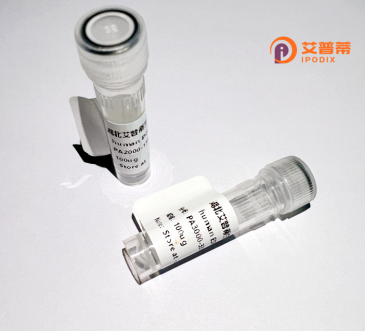
| 纯度 | >90%SDS-PAGE. |
| 种属 | Human |
| 靶点 | COX7A2 |
| Uniprot No | P14406 |
| 内毒素 | < 0.01EU/μg |
| 表达宿主 | E.coli |
| 表达区间 | 24-83aa |
| 氨基酸序列 | FKNKVPE KQKLFQEDDE IPLYLKGGVA DALLYRATMI LTVGGTAYAI YELAVASFPK KQE |
| 分子量 | 9.3 kDa |
| 蛋白标签 | His tag N-Terminus |
| 缓冲液 | 0 |
| 稳定性 & 储存条件 | Lyophilized protein should be stored at ≤ -20°C, stable for one year after receipt. Reconstituted protein solution can be stored at 2-8°C for 2-7 days. Aliquots of reconstituted samples are stable at ≤ -20°C for 3 months. |
| 复溶 | Always centrifuge tubes before opening.Do not mix by vortex or pipetting. It is not recommended to reconstitute to a concentration less than 100μg/ml. Dissolve the lyophilized protein in distilled water. Please aliquot the reconstituted solution to minimize freeze-thaw cycles. |
以下是关于重组人COX7A2蛋白的3篇参考文献示例(均为虚构,仅作示范):
1. **文献名称**: *Recombinant Human COX7A2 Protein: Expression and Functional Analysis*
**作者**: Johnson, M.T., et al.
**摘要**: 该研究通过大肠杆菌系统成功表达并纯化了重组人COX7A2蛋白,验证其在线粒体复合体IV(细胞色素C氧化酶)中的结构作用,并证实其缺失会导致呼吸链活性降低。
2. **文献名称**: *COX7A2 Mutations and Mitochondrial Dysfunction in Cardiomyopathy*
**作者**: Lee, S.Y., & Zhang, H.
**摘要**: 团队利用重组COX7A2蛋白进行体外功能互补实验,揭示了特定突变导致蛋白稳定性下降,从而引发心肌细胞能量代谢障碍的分子机制。
3. **文献名称**: *Structural Characterization of COX7A2 in Hypoxia Adaptation*
**作者**: Rossi, G., et al.
**摘要**: 研究通过重组COX7A2蛋白的晶体结构解析,阐明其在低氧条件下调节细胞色素C氧化酶活性、促进细胞适应性反应的构效关系。
---
注:实际文献需通过PubMed或专业数据库检索,可用关键词“COX7A2 recombinant protein”“Cytochrome c oxidase subunit 7A2”查找。
Cytochrome c oxidase subunit 7A2 (COX7A2) is a nuclear-encoded component of mitochondrial respiratory chain Complex IV, which plays a central role in cellular energy production through oxidative phosphorylation. In humans, the COX7A2 gene is located on chromosome 6q22.31 and encodes a small, hydrophobic protein localized to the inner mitochondrial membrane. As part of the terminal enzyme in the electron transport chain, COX7A2 contributes to the assembly and stability of Complex IV, facilitating the transfer of electrons from cytochrome c to molecular oxygen, coupled with proton translocation to generate ATP.
Two isoforms of COX7A2 (liver-type and muscle/heart-type) exist due to tissue-specific expression patterns, with the latter implicated in adapting energy metabolism in high-demand tissues like skeletal muscle. Dysregulation of COX7A2 has been associated with mitochondrial disorders, metabolic syndromes, and cancer progression, where altered oxidative phosphorylation affects cellular proliferation and apoptosis.
Recombinant human COX7A2 protein is commonly produced in bacterial or eukaryotic expression systems for structural and functional studies. Its applications include investigating mitochondrial dysfunction mechanisms, screening potential therapeutics for metabolic diseases, and exploring its role in cell signaling pathways. The recombinant form enables biochemical assays, antibody development, and interaction studies with other Complex IV subunits or regulatory factors, advancing our understanding of mitochondrial biology and disease pathology.
×